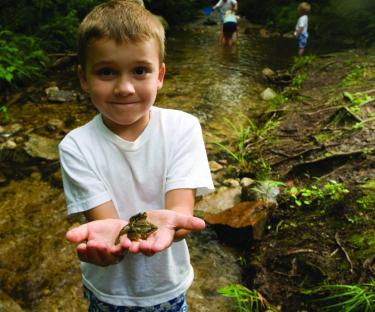Habitat for Fish and Other Aquatic Species
Just like woodland wildlife, fish have some basic needs that must be met—adequate food, shelter and the ability to move around and reproduce. Good managers can take steps to improve fish habitat to maximize the health, size, population and balance of freshwater fish on their property.
Specific fish specieis are sensitive to many elements in their environment, including water temperature, oxygen levels, food supplies, pH levels, substrates, depth and velocity of water, and availability of migration routes. If you are managing for specific fish types, you'll need to pay attention to these features of your water bodies.
However, all fish need healthy, pollution-free waters that provide them good food and shelter. This section shows you how to improve the health of aquatic habitats on your land, whether you're managing streams, rivers,ponds or lakes, and whether your species of interest are native fish or sport fish.
How to create a healthy habitat for fish:
As a landowner, you have control of a number of factors that influence the quality of fish habitats, including aquatic plants, habitat structures and water quality.
- Water quality: Reducing the amount of pollution, in the form of sewage, fertilizer, pesticides and herbicides and garbage, entering the water is the most direct way to improve water quality. This can be done by reducing soil erosion and runoff from forest roads and cultivating a buffer zone around the water, and through cleanup efforts.
- Aquatic plants: They produce oxygen, improve water quality, attract food, provide cover and serve as feeding and nesting habitats for wildlife. But when aquatic plants begin to dominate, they can cause die-offs. There are various mechanical, biological and chemical methods to control aquatic plants, such as cutting, uprooting, poisoning and introducing fish that eat vegetation. But the best way to control their growth is by limiting the amount of plant food that enters an ecosystem in the form of sewage, fertilizer and tillage.
- Habitat structures: Underwater structures within an aquatic habitat provide cover where fish can rest, hide from predators, feed or spawn. They are also where the bottom of the food chain -- algae and phytoplankton -- develops. Natural or man-made objects such as logs, rocks and boulders, brush bundles, artificial reefs and even discarded Christmas trees can be sunk and used to add form to the bottom of a water body.
To find out how to care for the water on your property, follow these links:
Where to get help:
George and Wanda Barrs, 2009 National Outstanding Tree Famers of the Year, have a simple wildlife management philosophy: “Listen, learn and grow.” Over the years, as they’ve added a lake, two fish ponds and duck pond to their Georgia property, they’ve sought the advice of wildlife biologists and other natural resource professionals—both to limit the impact of excavations on the surrounding forest and to maximize their wildlife conservation efforts.
The following resources are available to private landowners, such as the Barrs, who are seeking to make habitat improvements.
- Aquatic wildlife professionals: A local natural resource professional can provide guidance on habitat restoration, cultivating sport fish and more. Your state’s wildlife agency can put you in touch with one.
- State and federal programs: Your state’s wildlife agency may also offer voluntary incentive programs for landowners to improve aquatic habitats, or to direct you to federal resources such as the U.S. Fish and Wildlife Service’s Partners for Fish and Wildlife Program. The Partners Program provides technical and financial assistance to private landowners working to conserve or restore threatened ecosystems, including rivers and streams. Your state’s Extension service, listed on this USDA website, is a great starting point for education resources.
- Not-for-profit organizations: National not-for-profit organizations such as Trout Unlimited, Wild Salmon Center, American Rivers and many others may be able to assist private landowners.
How can I get more tips?
It’s simple! Enter your email below.

